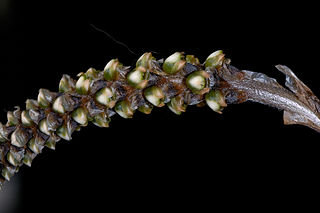
Aa is a genus of plants of the family Orchidaceae.

Stanhopea is a genus of the orchid family (Orchidaceae) from Central and South America. The abbreviation used in horticultural trade is Stan. The genus is named for the 4th Earl of Stanhope (1781-1855), president of the Medico-Botanical Society of London (1829-1837). It comprises 55 species and 5 natural hybrids. These epiphytic, but occasionally terrestrial orchids can be found in damp forests from Mexico to Trinidad to NW Argentina. Their ovate pseudobulbs carry from the top one long, plicate, elliptic leaf.

Chusquea is a genus of evergreen bamboos in the grass family. Most of them are native to mountain habitats in Latin America, from Mexico to southern Chile and Argentina.
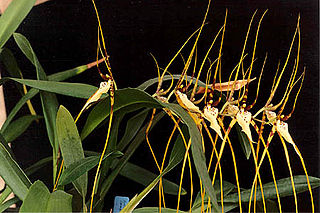
Brassia is a genus of orchids classified in the subtribe Oncidiinae. It is native to Mexico, Central America, the West Indies, and northern South America, with one species extending into Florida.

Ponthieva is a genus in the orchid family (Orchidaceae), commonly known as the shadow witch. They are named after Henry de Ponthieu, an English merchant of Huguenot ancestry who sent West Indian plant collections to Sir Joseph Banks in 1778.
Aphanactis is a genus of flowering plants in the family Asteraceae.

Brunellia is a genus of trees. They are distributed in the mountainous regions of southern Mexico, Central America, West Indies, and South America. Brunellia is the only genus in the family Brunelliaceae. As of 2001 there were about 54 species.
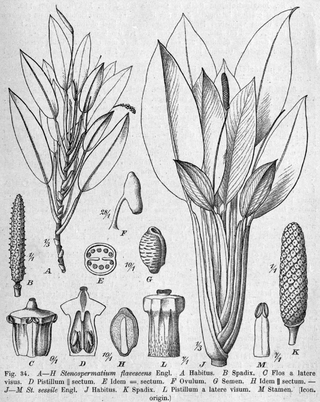
Stenospermation is a genus of plant in family Araceae native to South America and Central America.

Rodriguezia, abbreviated Rdza. in the horticultural trade, is a genus of orchids. It consists of 49 known species, native to tropical America from southern Mexico and the Windward Islands south to Argentina, with many of the species endemic to Brazil.

Polycycnis, abbreviated in horticultural trade as Pcn, is a genus of orchid, comprising 17 species found in Central America, and northern South America.
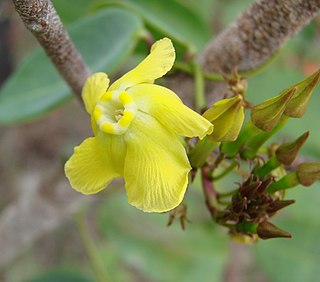
Prestonia is a genus of plants in the family Apocynaceae, first described as a genus in 1810. It is native to Mexico, Central America, South America, and the West Indies. It is closely related to Artia and Parsonsia.

Ruehssia cundurango is a species of plant of the genus Ruehssia native to Colombia, Ecuador and Peru in South America. It has the common name condurango. The subspecies Ruehssia cundurango subsp. cundurango is known to contain conduritol, a cyclitol or cyclic polyol. It was first isolated in 1908 by K. Kübler from the bark of the vine.

Pterichis is a genus of flowering plants from the orchid family, Orchidaceae. It is native to South America, Central America and Jamaica.

Sarcoglottis is a genus of flowering plants from the orchid family, Orchidaceae. It is widespread across much of Latin America from Mexico to Argentina, with one species extending northward into Trinidad and the Windward Islands.
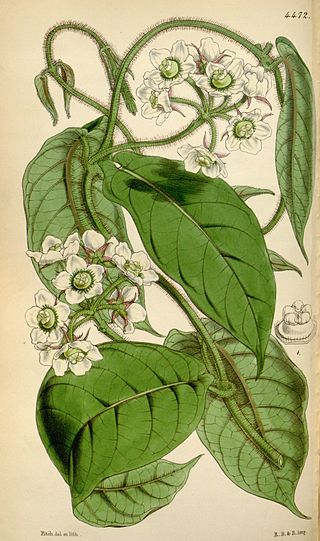
Fischeria is a plant genus in the family Apocynaceae, first described as a genus in 1813. It is native to South America, Central America, southern Mexico, and the West Indies.
Tassadia is a genus of plants in the family Apocynaceae, first described as a genus in 1844. It is native primarily to South America, with one species extending north into Central America, S Mexico, and Trinidad.
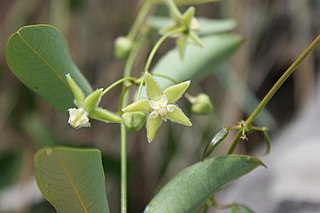
Blepharodon is a genus of plant in the family Apocynaceae, first described as a genus in 1844. They are native primarily to South America, with one species extending into Central America and Mexico.

Philibertia is a genus of flowering plants in the family Apocynaceae, first described as a genus in 1819. It is native to South America.
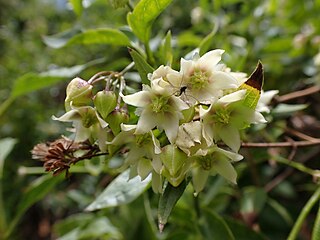
Jobinia is a genus of flowering plants of the family Apocynaceae first described in 1885. It is native to South America and Central America.

Ruehssia is a genus of plants in the family Apocynaceae. It is also in the Asclepiadoideae subfamily and Marsdenieae tribe.

















